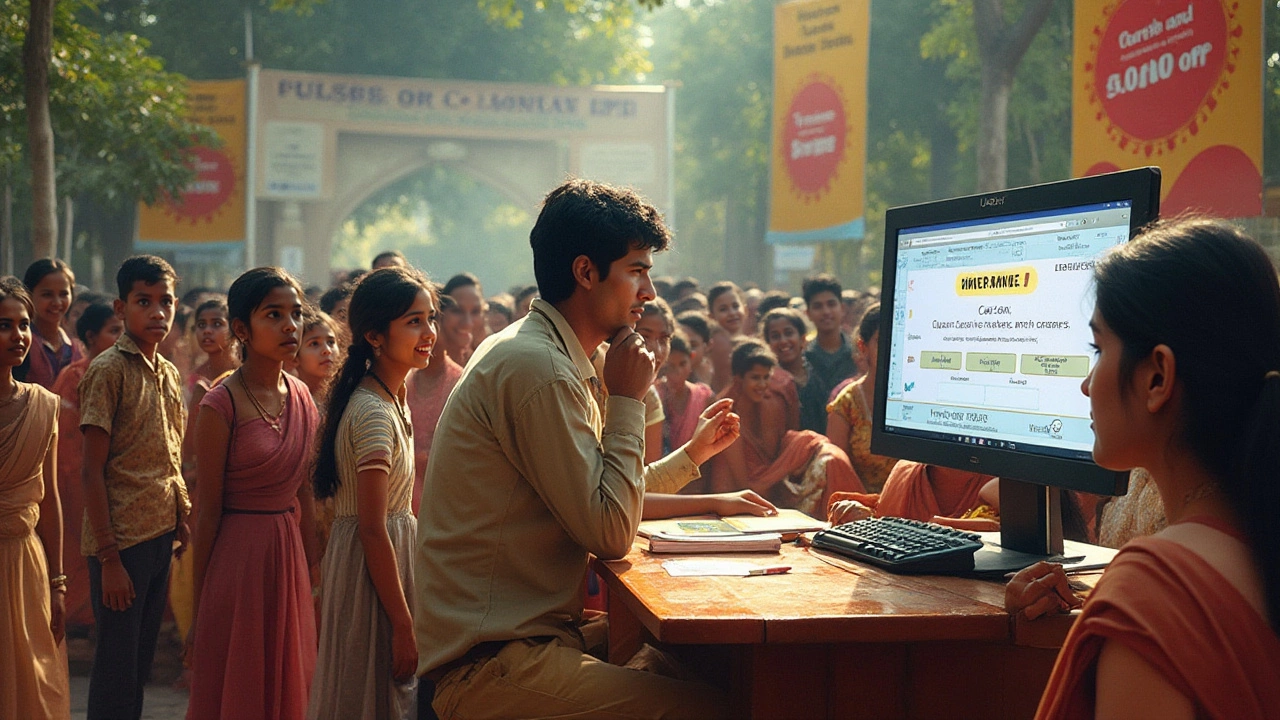Navigating the competitive realm of IIT JEE can be a daunting task, especially when aiming for one of India’s most prestigious institutions, IIT Bombay. A common question that lingers in the minds of aspirants is whether securing a rank around 5000 is sufficient to secure a spot in this distinguished institution. As we dive into this thought-provoking question, it's essential to consider the dynamic nature of cut-offs, seat allocation trends, and the variety of programs available.
While a rank of 5000 might seem borderline, understanding the nuances of IIT Bombay's admission process can open doors to potential opportunities. Historical data often shows shifts in the cut-off rankings based on factors like course popularity, reservation policies, and seat increments. By aligning expectations with available options and preparing a strategic plan tailored to rank, aspirants can still hold a hopeful gaze towards the doors of IIT Bombay.
- Understanding IIT Bombay's Cut-off Trends
- Factors Influencing Admission Chances
- Choosing the Right Course
- Tips for Aspiring Candidates
Understanding IIT Bombay's Cut-off Trends
Gaining admission to IIT Bombay with a competitive rank like 5000 requires a fine understanding of the institute's ever-evolving cut-off trends. The cut-off scores are influenced by various factors, each playing a crucial role in shaping the possibilities for aspiring engineers each year. One of the fundamental aspects that applicants must grasp is the fluctuation in seat allocations, which directly impacts the cut-off ranks for different courses. Each engineering discipline has its unique set of demands, and these often result in varied cut-off ranks across categories.
Historical analysis of the cut-off trends shows that while core branches such as Computer Science and Electrical Engineering tend to have higher cut-offs, disciplines like Metallurgical or Environmental Engineering might be more accessible within a 5000 rank. Several variables such as the number of seats offered, reservation policies, and the previous year's admission trends can contribute to shifts in these rankings. Understanding these elements can offer insightful perspectives into how candidates must prepare for their own admission strategies.
The opening and closing ranks at IIT Bombay are significant factors to consider when evaluating which courses might be available. Open Category candidates often face stiffer competition due to the sheer volume of applicants, whereas reserved categories like SC, ST, and OBC might observe slightly relaxed cut-offs. Knowledge of these distinctions helps aspirants tailor their expectations accordingly. According to an observation by the Joint Seat Allocation Authority (JoSAA), trends over the past few years have illustrated that branches with interdisciplinary approaches or emerging technologies sometimes witness a dip in cut-off ranks, presenting opportunities for students who are flexible with their fields of interest.
Reputed educational platforms frequently offer insights into the probable ranks needed for admission into specific courses. Data platforms provide curated insights into past cut-offs, helping students draw comparisons and make informed decisions. As the admission process intricacies unfold, aligning one's aspirations with these trends can significantly enhance the chances of securing a seat. Engaging actively with these trends and keeping abreast of annual shifts allows students to craft an agile plan when filling in their preferences.
This ever-dynamic nature of IIT Bombay's cut-offs emphasizes not only the importance of a competitive JEE score but also the strategic positioning of choices during counseling. Aspirants need to be well-versed in historical shifts to navigate the labyrinth of course preferences tactfully. A balanced approach, combining a high JEE rank with strategic course selection based on cut-off realities, forms the cornerstone of potential success in gaining admission to one of the country's premier institutes.
"As the demand for interdisciplinary courses rises, there's a noticeable shift in cut-off trends, making it essential for aspirants to stay informed," says an education analyst from Times of India.
The admissions game is a complex one, intertwined with a series of logical choices and timely decisions. By decoding cut-off trends, an aspirant can transform what appears to be a long shot into a tangible offer of admission. The journey to IIT Bombay is as much about understanding these trends as it is about securing a high JEE rank.

Factors Influencing Admission Chances
When it comes to clinching a spot in IIT Bombay with a 5000 rank, several aspects come into play, shaping the outcome of an aspirant's efforts. Firstly, past cut-off trends provide a valuable lens through which students can understand their prospects. These trends fluctuate depending on various influences such as seat availability and category-based reservations. The increase in new courses and the introduction of additional seats can also shift cut-off rankings, which makes it important to keep track of these developments.
Additionally, the precise course chosen by the aspirant can heavily sway admission chances. Each program in IIT Bombay comes with its own set of cut-off ranks that vary annually. For instance, courses like Computer Science often have higher cut-off ranks compared to newer or less conventional programs. Opting for a course with a marginally lower demand could potentially secure a seat for those on the borderline of their desired rank. Prospective students must weigh their interests against the realistic possibilities provided by these rankings.
Another key player is the reservation system, which allocates a certain percentage of seats to different categories. This framework significantly affects cut-offs as seats are specially reserved for OBC, SC, ST, and economically weaker sections. Depending on the category one falls under, the same 5000 rank might translate to different admission outcomes. Understanding the role of these reserved quotas can aid aspirants in efficiently planning their application strategy.
An often-overlooked factor in determining admission chances is the applicant's performance in the JEE Advanced test relative to peers. Even if the dream course seems out of reach at first glance, a remarkable performance shift in post-result preference rounds or seat-filling iterations can alter possibilities dramatically. Due diligence in preparing for these bridge-course options or additional rounds can make a world of difference.
Further, geographical diversity is sometimes encouraged by IIT Bombay, promoting a varied student body. So, where an aspirant hails from might just add an unexpected edge. While this isn’t a definitive criterion, it’s certainly among the many lesser-known tiebreakers during close calls.
And let’s not forget preparedness. Preparing ahead for potential rounds of counseling after JEE results, strategizing the filling of choices wisely, and staying updated with any announcements from IIT Bombay can keep students a step ahead. Engaging in forums, talking to alumni, and even preparing queries in advance for helpdesks can offer insightful guidance customized to real-time scenarios. As echoed by educational analysts, it's not just the rank you earn but how you use it that decides the future.

Choosing the Right Course
Selecting the optimal course at IIT Bombay when you have a rank around 5000 can significantly impact your academic journey and future career. Given that each course has unique cut-off ranks, understanding which courses are more accessible for your rank is crucial. While programs like Computer Science Engineering often record the highest cut-offs, there are other lucrative fields such as Material Science, Environmental Engineering, and Chemistry, which might have relatively lower cut-offs. This makes knowing your interests and career goals even more important, allowing you to align them with available opportunities at IIT Bombay.
Analyzing historical data indicates that certain courses exhibit a variance in their closing ranks every year. Such shifts could open paths to courses that one might not have initially considered. Strategically choosing less sought-after programs can serve as a springboard, should you aim to later transition into the desired specialization through branch change policies, albeit competitive. However, this option demands exceptional performance in the first year. Thus, being open to exploring diverse disciplines and understanding the interdisciplinary nature of many modern engineering roles can be beneficial in leveraging obtainable courses to craft a fulfilling educational experience.
Exploring Interdisciplinary Options
Another avenue prospective students should contemplate is the interdisciplinary programs offered. IIT Bombay has been innovating by introducing courses that traverse traditional boundaries. Programs like the Bachelor of Science in Economics or the dual-degree courses in Energy Science combine technical and analytical skills, which are invaluable in today's burgeoning sectors. By broadening the scope of acceptable courses, candidates with a 5000 rank can find themselves pursuing unique and rewarding curriculums that align with various industry demands.
Approaching IIT Bombay with a flexible mindset could align with the shifting paradigms in education, where interconnectivity between different fields is rapidly becoming the norm. For instance, courses with strategic importance in technology management or significant venture into data sciences can be captivating alternatives for students with diverse interests and ambitions. IIT Bombay admission decisions don't just hinge on immediate preferences, but also on assessing how coursework complements one's long-term aspirations.
"Smart class selection and understanding foundational subjects can be game-changers for those aiming to make their mark in niche areas," says Dr. Arun Grover, a veteran faculty member at IIT, underscoring the value of a well-thought-out curriculum choice.
This thoughtful approach to selecting a course ensures that you are not just competing within traditional expectations but are also embracing a wide array of opportunities that the institution offers. With a 5000 rank, aiming for the rightly aligned course at IIT Bombay can ultimately set a surprisingly robust foundation for your future endeavors, no matter the challenges that accompany the journey.

Tips for Aspiring Candidates
When considering securing a spot at IIT Bombay with a 5000 rank, it's vital to remain strategic and resourceful throughout the process. One of the first steps to consider is diving deeply into the previous year's opening and closing ranks for various programs. This data provides a solid foundation for understanding which courses were within reach for candidates with similar ranks. Additionally, it helps in identifying courses which might have less competition but still offer stellar educational opportunities. Candidates should also explore emerging or interdisciplinary programs that often present easier entry points yet promise strong prospects post-graduation.
An important aspect to keep in mind is the choice-filling strategy. Genuine introspection can significantly aid in making informed decisions. Prioritize courses not merely by cut-offs but by aligning them with personal interest and career goals. While securing a seat is important, ensuring that the chosen field resonates personally will make academic life more fulfilling and less daunting. It’s an exercise of marrying passion with pragmatism, something that can make the IIT journey much more rewarding.
Engaging with peers, mentors, or joining online communities such as Quora discussions or Reddit threads related to IIT JEE can provide insights and personal experiences of those who have tread the path before. Learn from their journeys—successes and setbacks alike—and adapt their strategies to fit personal circumstances. Access to such shared wisdom is invaluable, providing nuanced advice and sharpened perspectives that can guide one towards making astute decisions.
"Focus more on learning concepts and less on memorizing formulas. The ability to apply these in novel situations is what sets top candidates apart." — A suggestion widely shared by successful IIT graduates.
Moreover, staying informed about any changes in admission policies or seat allocations at IIT Bombay is crucial. Keeping an eye on official announcements is prudent, as shifts in such policies can directly affect admission chances. Regularly visiting the official JEE website or subscribing to newsletters from reputable educational portals ensures that no critical updates are missed. Missing out on vital information can make or break a candidate’s chances, especially in a competitive landscape such as engineering admissions.
Lastly, maintain a steady eye on mental and emotional health throughout the preparation and admission phases. The pressure is undeniably high, but ensuring a balanced routine with breaks and recreational activities can enhance overall performance. Establish a support system with family and friends, where stress and anxieties can be shared and managed effectively. The pathway to achieving an IIT Bombay admission is as much about resilience and well-being as it is about academic prowess.
